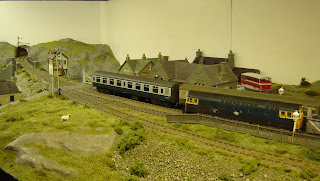
I've rather enjoyed Paul A Lunn's series of articles in Railway Modeller proposing micro-layouts, obviously enjoying micro-layouts myself I was pleased to get his book on the subject. It contains a selection of ideas similar to the articles in RM, with some attractively illustrated plans. To my mind many of the plans verge on the gimicky, with extremely short trains (30cm in OO gauge?!) and much use of traversers, sector plates and loco lifts in the operation of them - personally I prefer layouts with slightly more prototypical operation. Also I thought the text could have been more in-depth in places, explaining construction and operation better. However there are some great ideas, and the first section of the book gives good tips on designing small layouts.
The biggest omission to me though was Narrow Gauge - using NG is extremely popular in building micro-layouts, so it seems odd that it is not even mentioned. I guess the book is aimed at the mainstream, RTR-using modeller (all plans use OO scale), but scales such as 009 and O-16.5 are established and popular and given the subject of the book I think they should at least have been suggested.

This is another book of plans by Iain Rice, and those that have read his other books on the subject will find no surprises here, just lots of great ideas for layouts in a variety of spaces, all with good scenic and operational potential, and well-illustrated and explained. Some may not like his style, and not all his ideas will suit, but his approach to layout design has inspired me over the years. And yes, there is even a narrow-gauge plan!

A friend of mine is a big fan of the Sittingbourne 2'6" gauge railway and is planning a layout based on the Bowaters Paper Mill. I know very little about this system so when I saw this book by David Hammersley at EXPO-NG I had to get a copy (although the elves came and took it away so Santa could deliver it!). As the name suggests it is packed full of photo's, showing the atmosphere and detail of this industrial narrow-gauge empire, with a number of colour photos too. The captions are informative as is the brief introduction to the line, overall a great book for the narrow-gauge and/or industrial railway enthusiast, and for any modeller!
Wishing you all a Happy New Year, and hoping for some more productive modelling!






































